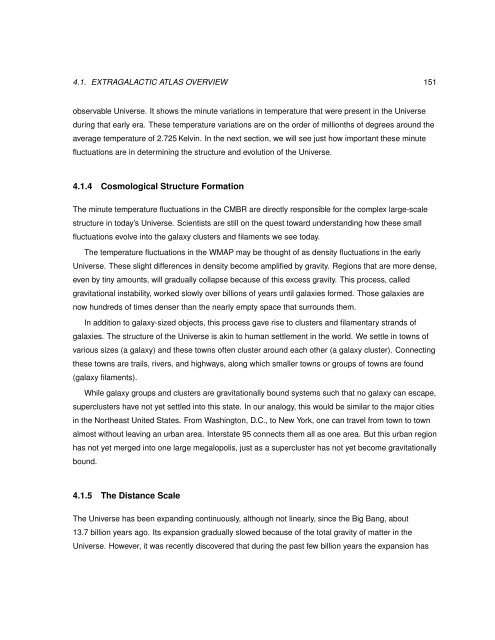Digital Universe Guide - Hayden Planetarium
Digital Universe Guide - Hayden Planetarium
Digital Universe Guide - Hayden Planetarium
Create successful ePaper yourself
Turn your PDF publications into a flip-book with our unique Google optimized e-Paper software.
4.1. EXTRAGALACTIC ATLAS OVERVIEW 151<br />
observable <strong>Universe</strong>. It shows the minute variations in temperature that were present in the <strong>Universe</strong><br />
during that early era. These temperature variations are on the order of millionths of degrees around the<br />
average temperature of 2.725 Kelvin. In the next section, we will see just how important these minute<br />
fluctuations are in determining the structure and evolution of the <strong>Universe</strong>.<br />
4.1.4 Cosmological Structure Formation<br />
The minute temperature fluctuations in the CMBR are directly responsible for the complex large-scale<br />
structure in today’s <strong>Universe</strong>. Scientists are still on the quest toward understanding how these small<br />
fluctuations evolve into the galaxy clusters and filaments we see today.<br />
The temperature fluctuations in the WMAP may be thought of as density fluctuations in the early<br />
<strong>Universe</strong>. These slight differences in density become amplified by gravity. Regions that are more dense,<br />
even by tiny amounts, will gradually collapse because of this excess gravity. This process, called<br />
gravitational instability, worked slowly over billions of years until galaxies formed. Those galaxies are<br />
now hundreds of times denser than the nearly empty space that surrounds them.<br />
In addition to galaxy-sized objects, this process gave rise to clusters and filamentary strands of<br />
galaxies. The structure of the <strong>Universe</strong> is akin to human settlement in the world. We settle in towns of<br />
various sizes (a galaxy) and these towns often cluster around each other (a galaxy cluster). Connecting<br />
these towns are trails, rivers, and highways, along which smaller towns or groups of towns are found<br />
(galaxy filaments).<br />
While galaxy groups and clusters are gravitationally bound systems such that no galaxy can escape,<br />
superclusters have not yet settled into this state. In our analogy, this would be similar to the major cities<br />
in the Northeast United States. From Washington, D.C., to New York, one can travel from town to town<br />
almost without leaving an urban area. Interstate 95 connects them all as one area. But this urban region<br />
has not yet merged into one large megalopolis, just as a supercluster has not yet become gravitationally<br />
bound.<br />
4.1.5 The Distance Scale<br />
The <strong>Universe</strong> has been expanding continuously, although not linearly, since the Big Bang, about<br />
13.7 billion years ago. Its expansion gradually slowed because of the total gravity of matter in the<br />
<strong>Universe</strong>. However, it was recently discovered that during the past few billion years the expansion has





